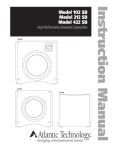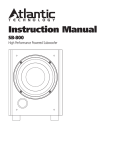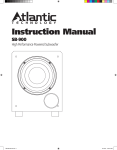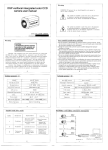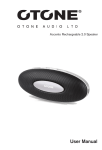Download Atlantic Technology System 1200 Instruction manual
Transcript
Instruction Manual SB-1000 High Performance Powered Subwoofer 2 Safety Precautions Model SB-1000 Powered Subwoofer Safety Precautions CAUTION: To reduce the risk of electric shock, do not remove the cover (or back). No user serviceable parts inside. Refer to qualified personnel. WARNING: To reduce the risk of fire or electric shock, do not expose this appliance to rain or moisture. This device generates a fair amount of heat. Make sure nothing blocks the ventilation openings on the top and bottom of the unit. The lightning flash with arrowhead, within an equilateral triangle, is intended to alert the user to the presence of uninsulated “dangerous voltage” within the product’s enclosure that may be of sufficient magnitude to constitute a risk of electrical shock to persons. The exclamation point within an equilateral triangle is intended to alert the user to the presence of important operating maintenance (servicing) instructions in the literature accompanying the appliance. For Future Reference Record your serial numbers and date of purchase here: Model Number Serial Number Date of Purchase The serial number is found on the back panel. Copyright © 2006 Atlantic Technology International. Specifications are those in effect at the time of printing. Atlantic Technology reserves the right to change specifications or designs at any time without notice. Model SB-1000 Specifications Bass Driver 10” long-throw Output Power 100W RMS Distortion (amplifier) <0.5% Frequency Response 32Hz – 140Hz ±3 dB Peak Output 105dB SPL into 2000 cubic Feet Dimensions (WxHxD) 20.5 x 12.8 x 17.1 in; 521 x 325 x 435mm including feet and grille Weight 38lbs/17.2kg Power Requirements 110-120/220-240V, 50/60Hz, 300W Max 3 Instruction Manual SB-1000 Subwoofer Rear Panel Figure 1 4 3 5 2 1 8 7 6 11 12 10 230V 115V 9 1 Bass Level Control 7 The outputs allow daisy chaining of multiple subwoofers, or as a return path back to the processor. Use this control to set the level of bass desired 2 Status LED This will be green for "on" condition, amber for "standby" 3 8 9 An adjustable (40Hz to 140Hz) @ 18dB per octave low-pass crossover. 10 This switch allows precise acoustic matching with satellite speaker systems whose output may be phase reversed. Try in both positions — use the position that results in the strongest bass output. 6 Crossover Switch When in the NORMAL position, adjustment of the crossover can be made by the Crossover Control. If being fed a pre-filtered or THX signal, place the switch at the BYPASS position. (pages 5 and 9) Voltage Select Switch Voltage switch for use in different countries. This switch will be set when you receive the unit. Change this setting only when you are sure your application requires it. For US, the switch should be set to the 115V position. Phase Switch 5 Product Serial Number Write this number in the space provided on page 2 for future reference. Crossover Control 4 Low Level Input Use the input to connect to the subwoofer or LFE line out from your processor/receiver. Standby Switch When in ON position, the amplifier will always be on. When in the AUTO position, the amplifier will be in Automatic Standby Mode. Low Level Output 11 On/Off Switch Use this switch to turn the amplifier completely on or off. 12 AC Input Use the included power cord to connect your amplifier to a wall outlet. 4 Model SB-1000 Powered Subwoofer Placement and Operation Generally speaking, the best location for your new subwoofer is the front of the room, close to a corner (Figure 5). Every room has its own unique sound characteristics, and flexibility in the exact placement of the subwoofer is always desirable. The closer the subwoofer is placed to a wall and especially a corner, the more and deeper the bass response you will hear. However, in some rooms, corner placement can produce a “one note” boomy effect. Under such circumstances the subwoofer may work better away from the corner. Experiment to find the best position in your room. Figure 5 Typical arrangement for a single subwoofer in a home theater. 2. Move to corner for more bass 1. Start here 3. Move away from wall for less bass ONthe Subwoofer AUTO STANDBY Using Crossover Control When used with the System 1200 or 2200, the Crossover control should be set at around 100Hz unless you are using a proCROSSOVER FREQUENCY cessor with its own built-in crossover. The goal is to optimize the performance of the 40 Hz 140 Hz system by ensuring that the subwoofer and satellites produce a cohesive and well integrated sound “picture.” Many surround sound receivers and processors offer a choice of crossovers, typically between 80 Hz and 120 Hz. If yours does, we recommend using the 100Hz setting when using small speakers such as those in the System 1200 or 2200. Consult your electronics owner's manual for more details. Higher crossover frequencies pass more bass but can sound boomy and may be more easily localized to the subwoofer. Higher crossover frequencies may be suitable, however, when using very small satellites that have no real low frequency performance. Settings lower than 80Hz should be employed if you are using larger speakers that have extended bass response. This way, the subwoofer will only reproduce the very lowest bass frequencies that are in the range where the large main speakers begin to roll off. It’s generally undesirable to have the main speakers and the subwoofer overlap too much. Larger speakers means a lower Low-pass crossover frequency, smaller speakers means a higher Low-pass crossover frequency. Consult the manufacturer’s specified low frequency response for your main speakers to determine the appropriate Low-pass setting on your subwoofer. In the end, however, a little time spent experimenting will generally result in dramatically better bass response. Care of Your Subwoofer Your subwoofer is constructed from 3/4” Medium Density Fiberboard. MDF is a non-resonant material ideal for speaker system enclosures. To clean the cabinet you may use a soft cloth either dry or slightly dampened with clean water. Be careful not to wet the cabinet or allow any water to enter the cabinet seams. Avoid placing your speakers in direct sunlight or near a source of heat that may, over time, damage the finish. 60 Hz NORMAL INVERT PHASE Subwoofer Troubleshooting Guide NORMAL BYPASS CROSSOVER Once your subwoofer is set up, you should have many years of maintenance free enjoyment from your system. However, if you should encounter a problem, refer to the following guide to help you find the solution. If a problem persists, you should contact your local authorized Atlantic RIGHT L / MONO Technology dealer. Problem No bass output Audible buzz or hum OUTPUT INPUT Possible Cause Possible Solution AC power cord unplugged or plugged into a non-working outlet. Plug into a working outlet. Input cables not securely connected or defective. Check all connections, then try another input cable. Input cable not securely connected or defective. Check all connections, then try another input cable. Ground loop through antenna or cable TV system input. Test by disconnecting antenna and/or cable system input leads. If hum goes away, install isolation balun(s) at that point. 015-1100




